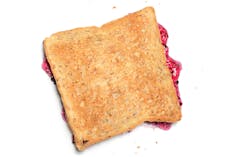
Does the food-on-the-floor-for-5-seconds rule work?
It happens, you’re in a hurry, you get distracted, the phone rings and before you know it, the food you were excited about is on the floor. But there’s the 5-second rule, right?
The Fresh Toast – Most people have done it, mostly in secret, but does the rule about taking 5 seconds to eat on the floor work?
High school student Jillian Clarke during a six-week food science internship Nutrition The University of Illinois at Urbana-Champaign department decided to find out what we are doing (whether it is right or wrong). Meredith Agle, a doctoral student at the time, supervised the study. So. She also conducted a survey in which 70% of women and 56% of men said they were familiar with the rule. Women are more likely to refer to it. Not surprisingly, people tend to eat dropped cookies and candy more often than dropped broccoli and cauliflower.
The urban food myth is that dirt and germs have little chance of contaminating food if it sits on the floor for just a few seconds. Research in my lab has focused on how food and food-contact surfaces become contaminated, and we have done some work on this particular wisdom.
Related: Weed and the munchies
While the “five-second rule” may not seem like the most pressing issue for food scientists to address, food myths like this one are still worth examining because they shape our beliefs about when food is safe to eat are.
It turns out that dropped food immediately picks up germs when it comes into contact with the ground, and the amount of bacteria transferred can be enough to make you sick, according to Paul Dawson, PhD, a professor of food science at Clemson University.
So is five seconds on the floor the critical threshold that separates an edible bite from food poisoning? It’s a little more complicated. It depends on how much bacteria can get from the floor to the food in a few seconds and how dirty the floor is.
A well-known but inaccurate story about Julia Child may have contributed to this food myth. Some viewers of her cooking show “The French Chef” claim they saw Child drop a lamb (or a chicken or a turkey, depending on your version of the story) on the floor and pick it up, pointing out when they were alone Your guests would never know the kitchen.
In fact, it was a potato pancake that fell on the stove and not on the floor. The child put it back in the pan and said, “But you can pick it up anytime, and if you’re alone in the kitchen, who will see it?” But the misremembered story remains.
Related: Late night treat, grilled oysters and biscuits
What does science tell us about what a few moments on the ground mean for the safety of your food?
Paul Dawson, a professor of food science at Clemson University, published a study in the Journal of Applied Microbiology – the only peer-reviewed article on the topic. The aim was to find out whether the length of time food is in contact with a contaminated surface affects the speed of transfer of bacteria to the food.
To find out, they inoculated squares of tiles, carpet or wood with salmonella. Five minutes later, bologna or bread was placed on the surface for five, 30, or 60 seconds. They then measured the amount of bacteria transferred to the food. They repeated this exact protocol after the bacteria had been on the surface for two, four, eight and 24 hours.
 Toast via www.shutterstock.comSplash.
Toast via www.shutterstock.comSplash.
We found that the amount of bacteria transferred to both types of food did not depend significantly on how long the food was in contact with the contaminated surface – whether for a few seconds or a full minute. Of greater importance was the total amount of bacteria on the surface, which decreased with time after the first inoculation. Apparently it’s less about how long your food stays on the floor and more about how badly the spot on the floor is infected with bacteria.
They also found that the type of surface also made a difference. Carpet, for example, seems to be a slightly better place to put food than wood or tile. When carpets were inoculated with salmonella, less than 1 percent of the bacteria were transmitted. But if the food came into contact with tiles or wood, 48 to 70 percent of the bacteria were transferred.
A study from Aston University in the United Kingdom used nearly identical parameters and found similar results when testing contact times of three and 30 seconds on similar surfaces. They also reported that 87 percent of respondents either would eat or had eaten food that fell on the floor.
Should you eat food that fell on the floor?
From a food safety perspective, 0.1 percent is still enough to make you sick if you have millions or more cells on a surface. In addition, certain types of bacteria are extremely virulent and even a small amount is enough to make you sick. For example, 10 cells or fewer of a particularly virulent strain of E. coli can cause severe illness and death in people with weakened immune systems. However, the likelihood of these bacteria being present on most surfaces is very low.
And it’s not just dropping food on the floor that can lead to bacterial contamination. Bacteria are transmitted through various “media” including raw foods, moist surfaces where bacteria remain, our hands or skin, and by coughing or sneezing.
Related: How Spam Became One of the Most Iconic American Brands of All Time
Hands, food, and utensils can carry individual bacterial cells, colonies of cells, or cells living in communities, surrounded by a protective film that provides protection. These microscopic layers of debris containing bacteria are called biofilms and are found on most surfaces and objects.
Biofilm communities can harbor bacteria for longer periods of time and are very difficult to clean. Bacteria in these communities also exhibit increased resistance to disinfectants and antibiotics compared to bacteria living alone.
So next time you think about eating dropped food, chances are good that you can eat that bite without getting sick. But in the rare case that there is a microorganism in the exact spot where the food fell that can make you sick, you can be fairly certain that the bug is on the food you just dropped take your mouth.
Research (and common sense) shows that it’s best to keep hands, utensils, and other surfaces clean.

Post a comment: